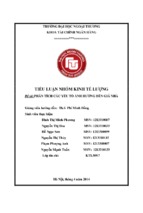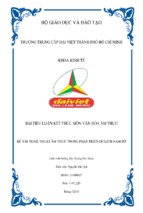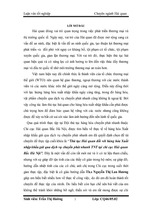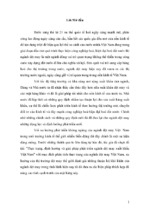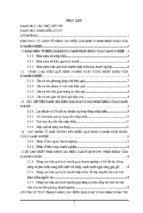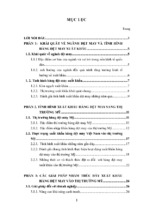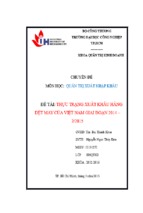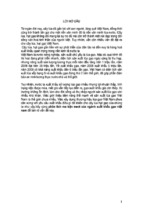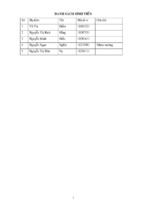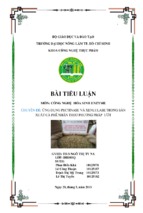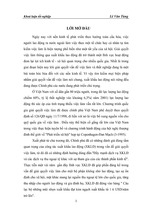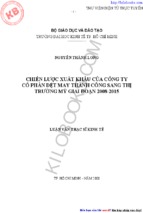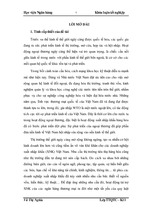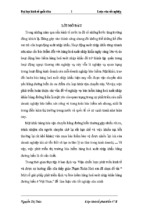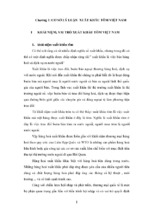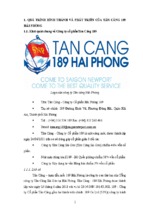ACKNOWLEDGEMENT
Firstly, I would like to express my appreciation to Dr. Nguyen Thi Mai Trang, my project
tutor, for all her valued guidance and expert advice in the preparation of this project.
Special thanks to my mentor for her personal encouragement and and unlimited support in
sharing marketing experience which motivated me to work harder on this project.
Last but not least I would like to send my deepest appreciation to my family and my
company for their emotional support and spiritual encouragement throughout my MBA
study.
TUTOR’S COMMENTS
I am writing to certify that this project entitled:
MARKETING STRATEGY FOR LAUNCHING SLIM SLIM IN 2011
A product belongs to the anti-obesity market & slimming food supplement category
Prepared by
Ms. PHAM THI THANH THUY
meets the requirement for a business project at the master’s level. It is recommend that
Pham Thi Thanh Thuy present her project to the Committee.
Hochiminh City, December 9th, 2010
___________________________________
Tutor’s signature
Nguyen Thi Mai Trang
TABLE OF CONTENTS
1
CHAPTER I INTRODUCTION ................................................................................................... 1
1.1
VIETNAM BEAUTY INC ........................................................................................................... 1
1.2
PROJECT BACKGROUND ........................................................................................................ 2
1.3
SCOPES AND LIMITATIONS ................................................................................................... 2
1.4
PROJECT OBJECTIVE ............................................................................................................... 3
1.5
PROJECT’S METHODOLOGY .................................................................................................. 3
1.6
DESCRIPTION OF CHAPTER ORGANIZATION ................................................................... 5
1.7
SUMMARY .................................................................................................................................. 5
2
2.1
CHAPTER II LITERATURE REVIEW .................................................................................... 6
MARKETING MIX ...................................................................................................................... 6
2.1.1
The Product ....................................................................................................................... 7
2.1.2
The Price ........................................................................................................................... 9
2.1.3
The Place ........................................................................................................................ 10
2.1.4
The Promotion ................................................................................................................ 10
2.2
TARGET MARKET ................................................................................................................... 12
2.3
POSITIONING ........................................................................................................................... 12
2.4
ATTITUDES AND BEHAVIORS OF CONSUMERS ............................................................. 13
2.5
2.6
2.4.1
Consumer behaviors ....................................................................................................... 13
2.4.2
Consumer attitudes ......................................................................................................... 13
2.4.3
Brand loyalty .................................................................................................................. 14
2.4.4
Brand equity ................................................................................................................... 14
CONSUMER RELATIONSHIP MANAGEMENT .................................................................. 14
2.5.1
Different types of consumer relationships .................................................................... 14
2.5.2
Building long term partnerships .................................................................................... 15
SUMMARY ................................................................................................................................ 16
3
CHAPTER III OVERVIEW OF VIETNAM BEAUTY INC AND ......................................... 17
ITS SLIM SLIM PRODUCT ............................................................................................................... 17
3.1
EXTERNAL FACTORS ............................................................................................................ 17
3.1.1
Political and legal ........................................................................................................... 17
3.1.2
Market situation .............................................................................................................. 17
3.1.3
Social-cultural ................................................................................................................. 19
3.1.4
Technological ................................................................................................................. 20
3.2
THE CORPORATION ............................................................................................................... 21
3.3
THE CUSTOMER ...................................................................................................................... 21
3.4
THE COMPETITORS ................................................................................................................ 23
3.5
SWOT ANALYSIS .................................................................................................................... 24
3.6
3.5.1
Strengths ......................................................................................................................... 25
3.5.2
Weaknesses .................................................................................................................... 25
3.5.3
Opportunities .................................................................................................................. 25
3.5.4
Threats ............................................................................................................................ 25
SLIM SLIM PRODUCT ............................................................................................................ 27
3.6.1
Product sustainable competitive advantages ................................................................ 28
3.6.2
Effect of Fiber and Psyllium .......................................................................................... 28
3.7
COMPETITIVE LANDSCAPE ................................................................................................. 29
3.8
KEY TO SUCCESS .................................................................................................................... 35
3.9
SUMMARY ................................................................................................................................ 35
4
CHAPTER IV MARKETING STRATEGY ............................................................................ 36
4.1
MARKETING OBJECTIVES .................................................................................................... 36
4.2
FINANCIAL OBJECTIVES ...................................................................................................... 36
4.3
TARGET MARKET ................................................................................................................... 37
4.4
POSITIONING ........................................................................................................................... 39
4.5
MARKETING MIX .................................................................................................................... 40
4.5.1
Product ............................................................................................................................ 40
4.5.2
Price ................................................................................................................................ 41
4.5.3
Advertising and Promotion ............................................................................................ 42
4.5.4
Places/ Distribution channels ......................................................................................... 45
4.6
BUDGETING ............................................................................................................................. 47
4.7
IMPLEMENTATION MILESTONES ...................................................................................... 48
REFERENCE ..................................................................................................................................50
APPENDIX A – QUESTIONNAIRE .............................................................................................51
APPENDIX B – SPSS OUTPUTS ...................................................................................................58
Exhibit B1 – Brand awareness ..........................................................................................................58
Exhibit B2 – The brand was frequently purchased ..........................................................................58
Exhibit B3 – Weight of consumers .................................................................................................59
Exhibit B4 – Status of marriage ........................................................................................................59
Exhibit B5 – Reasons to use slimming food supplement products ..................................................59
Exhibit B6 – Advertising Activities were aware .............................................................................60
Exhibit B7 – Quality trustworthy slimming food supplement brand ...............................................60
Exhibit B8 – The most trusted source of information to choose a brand .........................................61
Exhibit B9 – Places where to purchase the product .........................................................................61
ABBREVIATIONS
HCM
Hochiminh (city)
VBI
The Vietnam Beauty INC. Compnay
DAV
Drug Administration of Vietnam
SPSS
Statistical Package for the Social Sciences
LIST OF TABLE
Table 2.1
Common Communication platform
11
Table 3.1
Sales of Slimming Products by Subsector: Value 2004 – 2009
18
Table 3.2
Sales of Slimming Products by Subsector: % Value Growth 2004 – 2009 18
Table 3.3
Forecast Sales of Slimming Products by Subsector:
% Value Growth 2009 - 2014
19
Table 3.4
Consumer Expenditure by Product Type – 1995/2000/2005/2010/2015 22
Table 3.5
SWOT analysis of VBI
27
Table 3.6
Data on historical market share 2006 – 2009
32
Table 3.7
Analysis on direct competitors
34
Table 4.1
Price Analysis in VND
41
LIST OF FIGURES
Figure 1.1
Research design
3
Figure 2.1
The Four P components of the Marketing Mix
6
Figure 3.1
Brand awareness
23
Figure 3.2
Competitors of VBI
24
Figure 3.3
Psyllium most commonly used all over the world
29
Figure 3.4
The brand was frequently purchased
31
Figure 4.1
Weight of consumers
37
Figure 4.2
Status of marriage
38
Figure 4.3
Reasons to use slimming food supplement products
39
Figure 4.4
Advertising Activities were aware
42
Figure 4.5
Obesity health risks
44
Figure 4.6
Quality trustworthy slimming food supplement brand
46
Figure 4.7
The most trusted source of information to choose a brand
46
Figure 4.8
Places where to purchase the product
47
Page 1
1
CHAPTER I
1.1
VIETNAM BEAUTY INC
INTRODUCTION
Vietnam Beauty INC (VBI) is a totally new private company in the beauty industry. The
company offers the combination of health and beauty. The company is solely engaged in
promotion and distribution of high quality pharmaceutical products that carry health
benefits as well as improving over all appearance from within. The basic products are
focused on health food items on skin whitening, skin rejuvenation, slimming, strengthening
the immune system against diseases, external skin enhancers like organic whitening soaps,
whitening scrubs, peeling sets, whitening creams, etc..
The company does the marketing and distribution for beauty products which be sourced by
the international creditable manufacturer at the Vietnamese market through a strong
system of local pharmacies over the country.
The mission of VBI is to provide best quality products that meet specific consumer’s
requirements. The company pledges to provide best service in a timely manner at fair,
competitive prices.
For the coming five years VBI seeks to achieve the following goals:
a)
b)
Non-financial goals
i.
To be a well-known distributor in health product area in HCM city.
ii.
To add a new product every two years.
iii.
To enter Hanoi market.
Financial goals
iv.
To obtain an average growing rate of 20% per year over time.
Until this moment, the company has not had any establishment in the market. The company
is implementing the exploration to launch their first product in the year 2011.
Page 2
1.2
PROJECT BACKGROUND
Prior to the Business Monitor International Ltd’s Report released in Nov 2010, Vietnam’s
emergence is as one of the most promising economies in Asia. A bustling market economy
has stimulated foreign investment and domestic entrepreneurship, which are now the prime
drivers of growth. As a result, the escalating emergence of numbers of middle and high
income white-collar workers is inevitable. Together with their high confidence in their
future success and economic status, it results in their incremental in disposable income.
The demand in work-life balance stimulates them to be appeared as an attractive and goodlooking people. And obesity is one of their primary emerging concerns. With the demand
being fuelled by rising obesity levels and increasing consumer disposable incomes,
slimming products has been growing rapidly in recent years and expected to achieve a
rocket double digit of growth in the next coming years. It is accessed as a most lucrative
market than ever.
Capturing the opportunity of the increasing demand on slimming products, VBI plans to
penetrate this segment by building up an effective marketing strategy for launching its first
product “SLIM SLIM”.
For the time being, there is no evaluation on marketing activities that will help the VBI’s
management know how to have a successful launching for its new product of slimming
food supplement into community. The board of management desires to implement a test
market, forecast financial plan, etc. in order to establish a marketing strategy for its new
product.
1.3
SCOPES AND LIMITATIONS
The mentioned project is conducted on end consumer in Ho Chi Minh city where is the first
and major market for Slim Slim in Vietnam. The quantitative survey will be conducted to
Page 3
explore the important functional benefits and key indicators which drive targeted
consumers to choose a slimming product.
The results obtained from the survey could be biased because of information collected
from the interviewees with different backgrounds. Some executives have provided general
answers or requested the author to keep some of their information confidential and served
for purpose of statistical calculation only given to the fierce competition in Vietnam.
1.4
PROJECT OBJECTIVE
The mentioned project is conducted to explore how the end consumer identify themselves
and anti-obesity demand, trend in anti-obesity segment, affordable and acceptable price
range, consumers’ perception of current brands in the market, unmet needs and ideal antiobesity brand for consumers. Above all of this exploration, the project is implemented to
provide VBI’s management board a marketing strategy for a successful launching Slim
Slim product in Hochiminh city market.
1.5
PROJECT’S METHODOLOGY
1. Research Methodology: Descriptive
2. Methodology of collecting data: Quantitative
3. Research tools: Face to face interview
4. Sampling
Irrespective of gender: Female, 22-45 years old
Geo Coverage: HCM city
Sample size: 120
5. Analyzing and findings
Figure 1.1- Research design
Page 4
This project aims to gain a better understanding of all information related to a successful
marketing strategy for launching Slim Slim, therefore, descriptive research purpose was
applied.
For the descriptive studies such as this one, the quantitative method for data collection and
analysis are appropriate. The primary data is generated by using face to face interview.
Around 120 respondents with irrespective of gender, age from 22 to 45, overweight and
concern on a safe method to lose weight for a good-looking, and who live in Hochiminh
city where is the first and major market for Slim Slim in Vietnam, will be interviewed.
Questions were asked accordingly to an interview guide (available in Appendix A), which
was prepared in advance in order to cover all topics connected to research questions of this
study. The questionnaires will be 20-30 minutes length survey analyzing on characteristic,
price and market share of main competitive product in local market. After screening
interview some members from big sports fit centers and others from beauty care website,
we got a number of 120 consumers using different slimming food supplement products, and
several findings resulted. The most relevant findings from the survey can be used for the
implication of VBI’s marketing strategy.
Beside the primary data, the available documents of the company and all the necessary
information regarding VBI are also used as the secondary data in order to effectively serve
for the study. Furthermore, the relevant statistic information and analyze reports from
Euromonitor, Vietnam Nutrition Institute, Salas-Salvado J. and other sources also have
been used to illustrate for the study. Based on the secondary data, the current beneficial
impact of new slimming product to end consumer can be evaluated and a suitable
marketing strategy could be proposed to apply for a successful Slim Slim launching project.
Page 5
1.6
DESCRIPTION OF CHAPTER ORGANIZATION
This study is organized into four chapters.
Chapter I – Introduction: This chapter introduces the background and defines the problems
of the project. It sets the project objectives and establishes the design of the research. It
shows how the workflow of project goes through the chapter organization.
Chapter II – Literature review: This chapter discusses the state of knowledge in marketing
communications and relevant concepts within the area of consumer behavior and consumer
relationship management.
Chapter III – Overview of Vietnam Beauty INC and it’s product, Slim Slim: This chapter
generally analysis the internal and external factors which influence to operation of
company. It also discusses the advantages and disadvantage of Slim Slim – the first product
which VBI intend to launch into HCMC market.
Chapter IV – Marketing Strategy: This chapter discusses project findings and its
implication into marketing strategy as well as the necessary control for the new product’s
launching project.
1.7
SUMMARY
This chapter provides the foundation and the blueprint for the study. The background of the
research, the research problem, scopes and limitations of the research, the research
objectives, design of the research and research methodology are discussed. The discussion
helps researcher describe and develop research roadmap for coming consecutive steps.
The next chapter will proceed with a detail description of literature review which provides
a theoretical foundation before data collection is commenced.
Page 6
2
CHAPTER II
LITERATURE REVIEW
Marketing mix
Product
Product variety
Quality
Design
Features
Brand name
Packaging
Sizes
Services
Warranties
Target
market
Price
List price
Discounts
Allowance
Payment period
Credit terms
Promotion
Sales promotion
Advertising
Sales force
Public relation
Direct marketing
Place
Channels
Coverage
Assortments
Locations
Inventory
Transport
Source: Marketing Management, Millennium Edition by Philip Kotler
Figure 2.1 – The Four P components of the Marketing Mix
2.1
MARKETING MIX
Marketing mix is the set of marketing tools that the company uses to pursue its marketing
objectives in the target market. Basically, marketing mix involves four Ps elements
including product, price, place, and promotion. The company need to create a successful
mix of the right product, sold at the right price, in the right place, and using the most
suitable promotion.
Page 7
2.1.1
The Product
2.1.1.1 What is Product?
The product is the central point on which marketing energy must focus. Finding out how to
make the product, setting up the production line, providing the finance and manufacturing
the product are not the responsibility of the marketing function. However, it is concerned
with what the product means to the consumer.
In marketing, the term Product is used as a catch-all word to identify solutions a marketer
provides to its target market. Marketing therefore plays a key role in determining such
aspects as the appearance of the product - in line with the requirements of the market, and
the function of the product - products must address the needs of consumers as identified
through market research.
The product range and how it is used is a function of the marketing mix. The range may be
broadened or a brand may be extended for tactical reasons, such as matching competition
or catering for seasonal fluctuations. Alternatively, a product may be repositioned to make
it more acceptable for a new group of consumers as part of a long-term plan.
2.1.1.2 Key product decision
The actual product is designed to provide the core benefits sought by the target market.
The company offers these benefits through a combination of factors making up the actual
product. There are four keys factors that together help shape the actual product including
Consumable Product Feature, Branding, Packaging and Labeling.
At this study, the factor of Consumable Product Feature and Branding would be mentioned.
Page 8
2.1.1.2.1 Consumable Product Feature
Features are characteristics of a product that offer benefits to the consumer. When it comes
to developing a consumable product, several decisions related to product features will be
faced, including:
Feature Set vs. Cost: An important decision focuses on the quantity and quality of features
(i.e., feature set) to include in a product. In most cases the more features included or the
higher the quality level for a particular feature, the more expensive the product is to
produce and market.
Is more better? Even if added cost is not a major concern, the company must determine if
more feature help or hurt the target market’s perception of the product. A product with too
many features could be viewed as too difficult to use.
Who should choose the features? Historically the company determined what features to
include in a product. For instance, companies offering website hosting services allow
website owners to choose from a list of service options that best suit their needs.
2.1.1.2.2 Branding
Branding involves decisions establishing an identity for a product with the goal of
distinguishing it from competitor’s offerings. In markets where competition is fierce and
where consumers may select from among many competitive products, creating an identity
through branding is essential. Is is particularly important in helping position the product in
the minds of the product’s target market.
Page 9
With competition growing more intense in almost all industries, establishing a strong brand
allows an organization’s products to stand out and avoid potential pitfalls. A clear
understanding of branding is essential in order to build a solid product strategy.
Individual Product Branding – with this branding approach new products are assigned new
names with no obvious connection to a company’s existing brands. Under individual
product branding, the company must work hard to establish the brand in the market since it
can not ride the coattails of previously introduced brands. The chief advantage of this
approach is it allows brands to stand on their own. This lessens threats that may occur to
other brands marketed by the company.
2.1.2
The Price
2.1.2.1 What is Price?
Of all the aspects of the marketing mix, price is the one, which creates sales revenue - all
the others are costs. The price of an item is clearly an important determinant of the value of
sales made. In theory, price is really determined by the discovery of what consumers
perceive is the value of the item on sale. Researching consumers' opinions about pricing is
important as it indicates how they value what they are looking for as well as what they
want to pay. A company’s pricing policy will vary according to time and circumstances.
2.1.2.2 Importance of pricing
Setting the right price level takes considerable market knowledge and, specially with new
products, testing of different pricing options. Often times consumers’ perceptions of a
product is formed as soon as they learn the price, such as when a product is first seen in a
store. While the final decision to make a purchase may be based on the value offered by
the entire marketing offering, it is possible the consumer will not evaluate a product at all
based on price alone. Otherwise, pricing may become the most important of all marketing
Page 10
decisions if it can be shown that consumers are avoiding learning more about the product
because of price.
2.1.3
The Place
Although figures vary widely from product to product, roughly a fifth of the cost of a
product goes on getting it to the consumer. 'Place' is concerned with various methods of
transporting and storing goods, and then making them available for the consumer. Getting
the right product to the right place at the right time involves the distribution system. The
choice of distribution method will depend on a variety of circumstances. It will be more
convenient for some manufacturers to sell to wholesalers who then sell to retailers, while
others will prefer to sell directly to retailers or consumers.
2.1.4
The Promotion
2.1.4.1 What is Promotion?
The role of promotion, is also termed as marketing communications, is very important as it
builds brand awareness, creates favorable brand attitudes and enhances purchase intention.
(Belch and Belch 1998; Rossister and Percy 1998).
Promotion is the business of communicating with consumers. It will provide information
that will assist them in making a decision to purchase a product or service. The razzmatazz,
pace and creativity of some promotional activities are almost alien to normal business
activities.
The cost associated with promotion or advertising goods and services often represents a
sizeable proportion of the overall cost of producing an item. However, successful
promotion increases sales so that advertising and other costs are spread over a larger
output. Though increased promotional activity is often a sign of a response to a problem
Page 11
such as competitive activity, it enables a company to develop and build up a succession of
messages and can be extremely cost-effective.
2.1.4.2 Promotion mix
Promotion is also termed as marketing communications. The role of marketing
communications is very important as it builds brand awareness, creates favorable brand
attitudes and enhances purchase intention. (Belch and Belch 1998; Rossister and Percy
1998)
Advertising
Print, broadcasts,
online ads
Packaging
Motion pictures
Brochures,
booklets
Sales promotion
Public relations
Personal selling
Contest, games,
sweepstake,
lotteries
Press kits
Sales
representation
Premiums, gifts
Sampling
Fair, tradeshow
Video news
releases
Speeches
Seminars
Annual reports
Directories
Demonstration
Billboards,
posters
Coupons
Charitable
donation
Rebates
Sponsorships
Low interest
financing
Publications
Display signs
Point of purchase
displays
Audio visual
materials
Websites and
banners
Trade-in
allowances
Continuity
program
Sales meetings
Incentive
program
Fairs and
tradeshows
Direct
marketing
Catalogue
Mailings
Telemarketing
Electronic
shopping
TV shopping
Fax
Email
Voice mail
Community
relation
Lobbying
Identity media
Special events
Source: Marketing Management, Millennium Edition by Philip Kotler
Table 2.1 – Common Communication platform
Page 12
2.2
TARGET MARKET
The target market and the marketing mix variables of product, place(distribution),
promotion and price are the two elements of a marketing mix strategy that determine the
success of a product in the marketplace.
A target market or target audience is a group of consumers that the business has decided to
aim its marketing efforts and ultimately its merchandise. A well-defined target market is
the first element to a marketing strategy.
Target markets are groups of people separated by distinguishable and noticeable aspects.
Target markets can be separated into geographic segmentations (their location);
demographic/socio-economic segmentation (gender, age, income occupation, education,
sexual orientation, household size, and stage in the family life cycle); psychographic
segmentation (similar attitudes, values, and lifestyles); behavioral segmentation
(occasions, degree of loyalty); and product-related segmentation (relationship to a product).
Once these distinct consumers have been defined, a marketing mix strategy of product,
distribution, promotion and price can be built by the business to satisfy the target market.
2.3
POSITIONING
The most common definition of positioning is identifying a market niche for a brand,
product or service utilizing traditional marketing placement strategies (i.e. price,
promotion, distribution, packaging, and competition).
Positioning is the perception that happens in the minds of the target market. It is the
aggregate perception the market has of a particular company, product or service in relation
to their perceptions of the competitors in the same category. It will happen whether or not a
company's management is proactive, reactive or passive about the on-going process of
- Xem thêm -


